
William James "Count" Basie was an American jazz pianist, organist, bandleader, and composer. In 1935, he formed the Count Basie Orchestra, and in 1936 took them to Chicago for a long engagement and their first recording. He led the group for almost 50 years, creating innovations like the use of two "split" tenor saxophones, emphasizing the rhythm section, riffing with a big band, using arrangers to broaden their sound, and others. Many musicians came to prominence under his direction, including the tenor saxophonists Lester Young and Herschel Evans, the guitarist Freddie Green, trumpeters Buck Clayton and Harry "Sweets" Edison, plunger trombonist Al Grey, and singers Jimmy Rushing, Helen Humes, Thelma Carpenter, and Joe Williams.

Joseph Vernon "Big Joe" Turner Jr. was an American blues shouter from Kansas City, Missouri. According to songwriter Doc Pomus, "Rock and roll would have never happened without him." His greatest fame was due to his rock-and-roll recordings in the 1950s, particularly "Shake, Rattle and Roll", but his career as a performer endured from the 1920s into the 1980s.
Boogie-woogie is a genre of blues music that became popular during the late 1920s, developed in African-American communities in the 1870s. It was eventually extended from piano, to piano duo and trio, guitar, big band, country and western music, and gospel. While standard blues traditionally expresses a variety of emotions, boogie-woogie is mainly associated with dancing and Boogie-woogie dance.
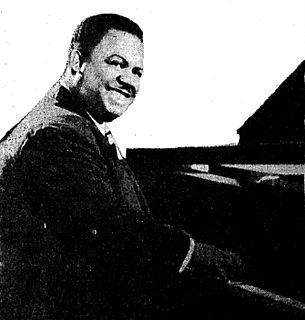
Anderson Meade Lewis, known as Meade Lux Lewis, was an American pianist and composer, remembered for his playing in the boogie-woogie style. His best-known work, "Honky Tonk Train Blues", has been recorded by many artists.
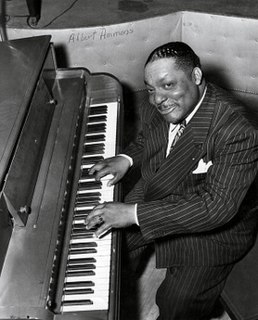
Albert Clifton Ammons was an American pianist and player of boogie-woogie, a bluesy jazz style popular from the late 1930s to the mid-1940s.
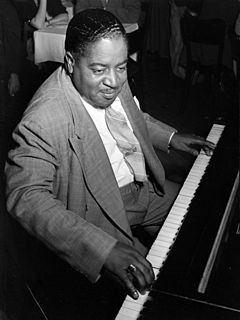
Pete Johnson was an American boogie-woogie and jazz pianist.
Clarence Smith, better known as Pinetop Smith or Pine Top Smith, was an American boogie-woogie style blues pianist. His hit tune "Pine Top's Boogie Woogie" featured rhythmic "breaks" that were an essential ingredient of ragtime music, but also a fundamental foreshadowing of rock & roll. The song was also the first known use of the term "boogie woogie" on a record, and cemented that term as the moniker for the genre.
"Honky Tonk Train Blues" is a song written by Meade Lux Lewis, and first recorded in 1927. A proto boogie-woogie song, it has many of the traits that would come to be identified with rock and roll. It is also the first recorded use of the term "honky tonk" in a song.
From Spirituals to Swing was the title of two concerts presented by John Hammond in Carnegie Hall on 23 December 1938 and 24 December 1939. The concerts included performances by Count Basie, Benny Goodman, Big Joe Turner and Pete Johnson, Helen Humes, Meade Lux Lewis, Albert Ammons, Mitchell's Christian Singers, the Golden Gate Quartet, James P. Johnson, Big Bill Broonzy and Sonny Terry.

Michael Kaeshammer is a Canadian jazz and boogie-woogie pianist.
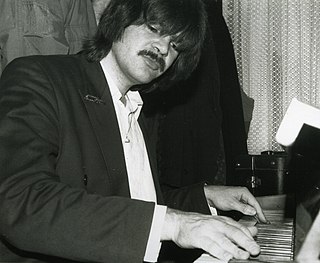
Axel Zwingenberger is a German blues and boogie-woogie pianist and songwriter.
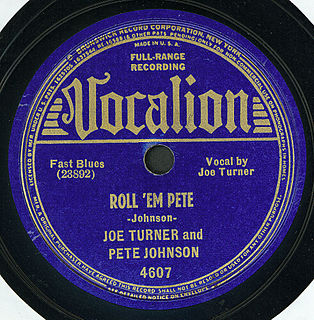
"Roll 'Em Pete" is a blues song, originally recorded in December 1938 by Big Joe Turner and pianist Pete Johnson. The recording is regarded as one of the most important precursors of what later became known as rock and roll.
Eddie Dougherty was an American jazz drummer.
Chronological Classics was a French compact disc reissue label. Gilles Pétard, the original owner, intended to release the complete master takes of all jazz and swing recordings that were issued on 78 rpm. By the time the label suspended operations in July 2008, its scope had extended to LPs.
Boogie-Woogie Dream (1944) is an independently made short film musical, directed by Hanus Burger, starring Lena Horne, Albert Ammons, Pete Johnson and Teddy Wilson and his orchestra. Scott Yanow identifies it as a sextet.

Robbert Arris Jules "Rob" Agerbeek is an Indo Dutch boogie-woogie and jazz pianist and winner of several jazz concourses in the Netherlands in the late 1950s. He is regarded as one of Europe's finest jazz pianists, covering the full spectrum of jazz styles from his early days of Boogie-woogie to Chicago traditional Jazz, swing and contemporary jazz.

The Original American Decca Recordings is a 1992 compilation 3-CD set of sessions led by jazz bandleader Count Basie recorded for the Decca label between 1937 and 1939.

"Boo-Woo" is the A-side of the 78-rpm jazz instrumental single recorded on February 1, 1939 by Harry James and The Boogie Woogie Trio.

"Woo-Woo" is the B-side of the 78-rpm jazz instrumental single recorded on February 1, 1939, by Harry James and The Boogie Woogie Trio.












